As runners, we’re no strangers to the elements. Whether it’s the relentless sun, the biting cold, or the unexpected downpour, we lace up and head out. But there’s one element that can dampen spirits and feet alike: water. This is where waterproof running shoes step in, offering a dry reprieve in a landscape often ruled by puddles, rain, and mud.
The importance of waterproof running shoes transcends mere comfort. For the dedicated runner, they are a shield against blisters and the chafing that comes with wet feet, a safeguard for the feet’s health, and a performance enhancer in inclement weather conditions. They ensure that a sudden change in weather doesn’t cut your run short or turn it into an ordeal.
As we explore the best waterproof running shoes on the market, we’ll explore how these technological marvels can keep you running longer and more comfortably, no matter what Mother Nature throws at you.
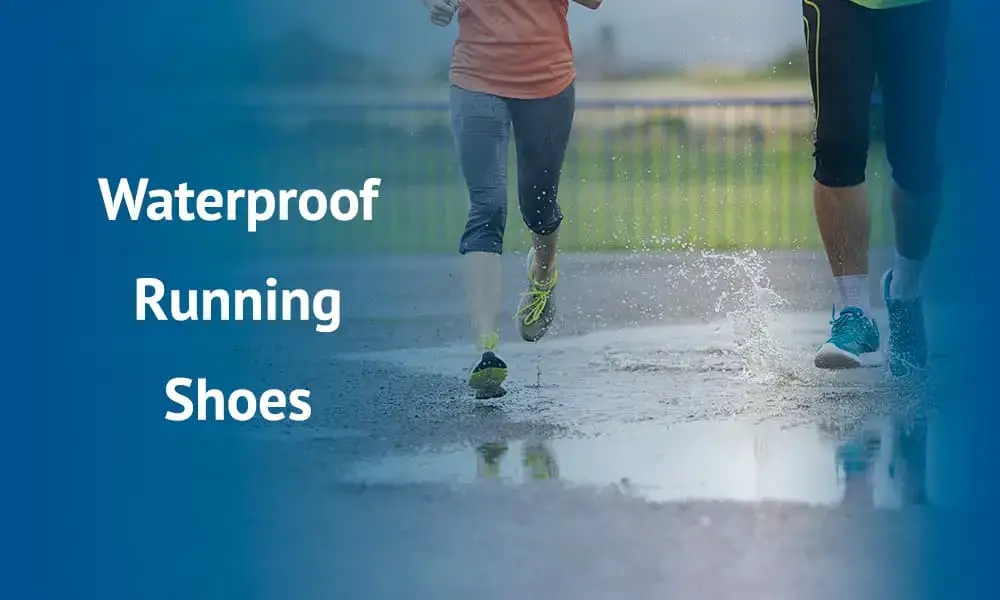
What Makes a Shoe Waterproof?
The quest for dry feet on wet runs has led to significant innovations in shoe technology, with waterproofing at the forefront. But what exactly makes a shoe waterproof, and how does it manage to keep the water out while still allowing your feet to breathe?
The secret lies in the membranes. A waterproof running shoe typically features a thin, microporous membrane that is incorporated into the upper part of the shoe. The most renowned of these is Gore-Tex, a material that has become almost synonymous with waterproof gear. This membrane has over 9 billion pores per square inch, each pore 20,000 times smaller than a water droplet, making it impenetrable by rain and puddles. Yet, these pores are large enough to allow water vapour—produced by sweating feet—to escape.
This delicate balance between waterproofing and breathability is crucial. Without breathability, the sweat produced by your feet would have no escape, leading to dampness from the inside. This is why simply wrapping your feet in plastic would not work; it would keep the rain out but trap sweat in, defeating the purpose of staying dry.
Manufacturers often enhance these membranes with additional technologies. For instance, some shoes are treated with Durable Water Repellent (DWR) coatings, which cause water to bead up and roll off the outer fabric, further preventing water from saturating the shoe’s exterior.
However, waterproofing continues beyond the materials. Design elements such as gusseted tongues, which are attached to both sides of the upper part of the shoe, prevent water from seeping in through the lace eyelets. Similarly, some models offer integrated gaiters or collars at the ankle for additional protection against deeper water and debris.
The challenge for manufacturers is to maintain this waterproofing over time. As shoes are subjected to the flexing and abrasion of regular running, the integrity of the waterproof membrane must hold up. This is where quality construction and materials come into play, ensuring that your investment remains sound over miles of wet running.
Top Waterproof Running Shoes for 2023
- Saucony Peregrine 13 GTX (Best Overall)
- Brooks Ghost 14 GTX (Best for Neutral Gait)
- Hoka Challenger 7 GTX (Versatile Hybrid)
- Nike Pegasus Trail 4 Gore-Tex (Best for Road and Trail)
- Adidas Terrex Agravic Flow 2.0 Gore-Tex (Best for Transitioning from Road to Trail)
Saucony Peregrine 13 GTX (Best Overall)
In the world of running shoes that are waterproof, the Saucony Peregrine 13 GTX emerges as the best overall for 2023, a beacon of reliability for trail runners who confront the elements head-on. This shoe is a testament to Saucony’s commitment to innovation, blending the ruggedness required for the trail with the comfort needed for long distances.
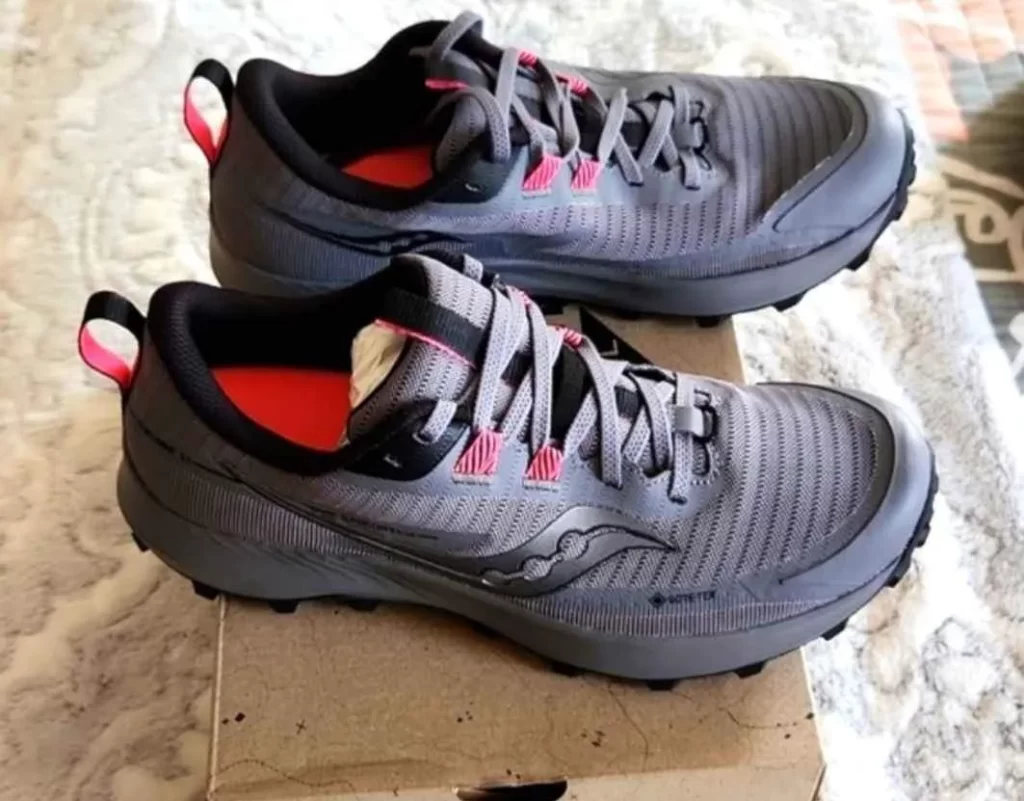
The Peregrine 13 GTX is not just a shoe; it’s a fortress for your feet, thanks to its Gore-Tex membrane, ensuring that each step you take is protected from water without sacrificing breathability. This model stands out with its aggressive lugs, which claw into the earth for unparalleled traction, making it a trustworthy companion on muddy paths and slippery slopes.
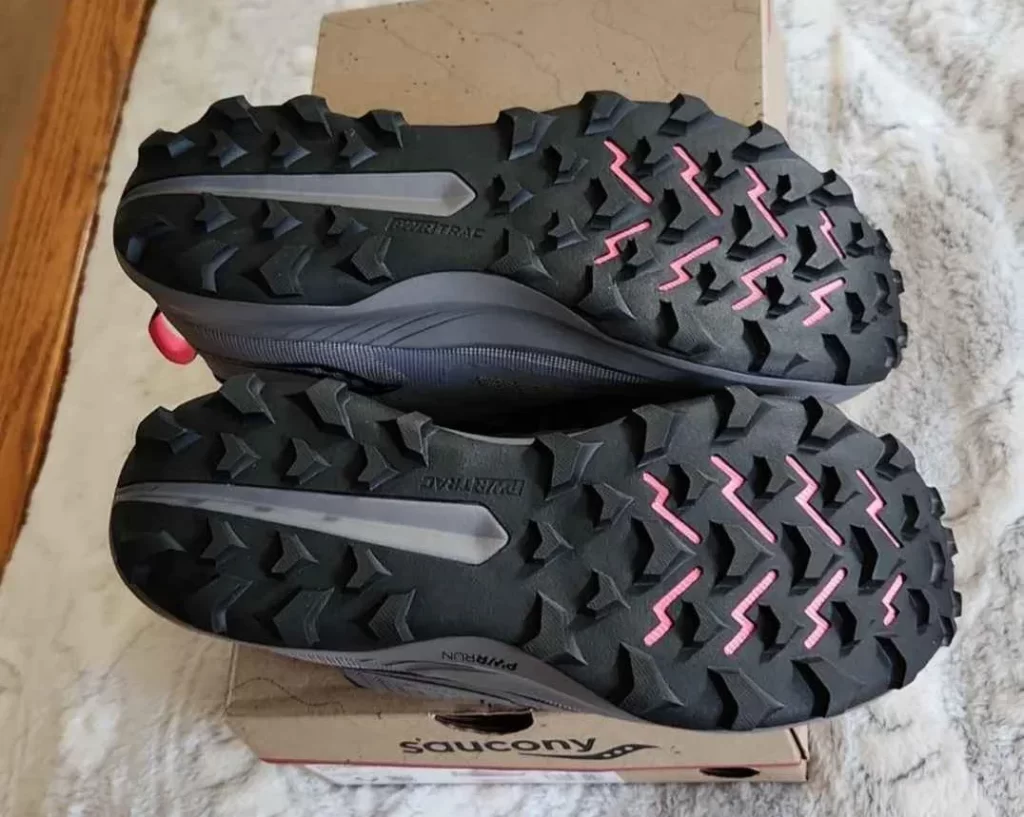
Durability is another hallmark of this shoe, with a robust upper that withstands the wear and tear of the trail while supporting and protecting your feet. The shoe’s design is sleek and nimble, avoiding the bulkiness often associated with waterproof footwear. It’s a shoe that feels as good as it looks, with a secure fit that hugs the foot and a responsive midsole that cushions each stride.
The Peregrine 13 GTX’s prowess is not limited to dryness alone. Its PwrRun midsole offers a slightly thicker slab of updated foam, providing a stable and responsive ride that’s protective enough to shield your feet from the treacherous underfoot. The 4 mm offset positions the runner for a natural stride, while the weight remains impressively light for such a fortified shoe.
On the run, the Peregrine 13 GTX doesn’t disappoint. It’s a shoe that feels at home on technical terrain, where precision is paramount. The FormFit lockdown system is a standout feature, offering a snug fit that moves with you, adapting to the foot’s shape and the dynamic demands of the trail.
Pros:
- Exceptional Waterproofing: The integrated Gore-Tex bootie extends to the top of the shoe, ensuring complete water protection even when fully submerged in a stream.
- Aggressive Traction: Equipped with PwrTrac outsole, the aggressive lug configuration offers excellent grip on various surfaces, making it ideal for technical trails.
- Durable and Protective Upper: The shoe’s upper is designed to withstand the rigours of the trail, offering a secure fit and ample protection for the foot.
- Responsive Cushioning: The updated PwrRun midsole provides a stable and responsive ride, with enough cushioning to protect against rough terrain without sacrificing ground feel.
- Adaptable Fit: Saucony’s FormFit system hugs the foot for a secure lockdown, while a slightly wider toebox after the break-in period accommodates thicker socks or wider feet.
Cons:
- Initial Stiffness: The Gore-Tex upper can feel stiff out of the box, requiring a break-in period for optimal flexibility and comfort.
- Narrow Fit: Some runners may find the fit a bit too narrow, particularly around the toe box, which could affect comfort on longer runs.
- Breathability Trade-off: While the Gore-Tex lining offers unbeatable waterproofing, it may not keep up with the heat generated by the feet, potentially leading to dampness from sweat.
- Traction on Wet Surfaces: Although the outsole performs well on most terrains, it may struggle with grip on wet wood or extremely slick rocks.
Brooks Ghost 14 GTX (Best for Neutral Gait)
As someone with a neutral gait, finding the right running shoe that provides both comfort and stability without overcorrecting can be a challenge. The Brooks Ghost 14 GTX is a shoe that understands this balance intuitively. After testing it out on various runs, from quick jogs to longer distances, it stands up to the promise of being a top pick for those with a neutral running style.
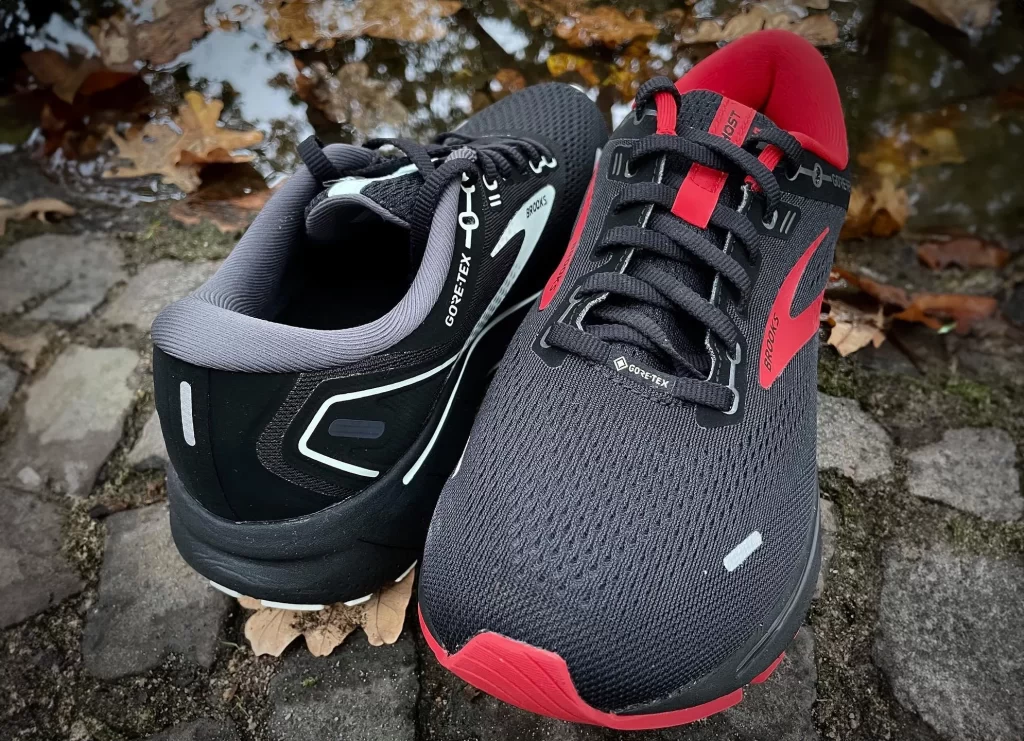
In my experience, the Brooks Ghost 14 GTX has been a revelation for wet-weather running. The moderate cushioning is a standout feature, providing a comfortable ride without dulling the sensation of the road beneath your feet. The Air Mesh upper, combined with the GORE-TEX® membrane, ensures that my feet stay dry even when the weather is not cooperating. The shoe’s overall stability is impressive, making it a solid choice for neutral runners who value a shoe that can handle both training days and race days with ease.
The Brooks Ghost 14 GTX is not just a shoe; it’s a reliable partner for the long haul, offering a blend of features that cater to the neutral runner’s needs. It’s a shoe that has earned its place at the top of my go-to list for when the skies turn grey and the roads get wet.
Pros:
- Moderate-Intensity Cushioning: The Ghost 14 GTX offers a Goldilocks cushioning that’s just right—not too soft, not too firm. It’s responsive enough to give you that springy lift-off yet substantial enough to absorb impact during long runs.
- Secure Air Mesh Upper: The upper is a fortress against the elements, thanks to the GORE-TEX® Invisible Fit membrane. It’s a lightweight shield that doesn’t compromise on flexibility or fit, hugging the foot securely while keeping it dry.
- Stable and Supportive: The shoe’s design provides a stable base, particularly noticeable in the heel counter, which adds to the overall support without the feeling of bulkiness.
- Durable Outsole: The outsole is made with a high-wear-resistant compound, offering reliable traction and grip across various surfaces.
Cons:
- Breathability: While the GORE-TEX® membrane is excellent for waterproofing, it does trade off some breathability. On warmer days, this could mean a bit more heat retention than non-waterproof counterparts.
- Heel Drop: With an 11mm drop, some runners might find the transition from heel to toe a bit more pronounced, which could affect those who prefer a more minimalist feel.
Hoka Challenger 7 GTX (Versatile Hybrid)
The Hoka Challenger 7 GTX is a testament to versatility in the world of waterproof running shoes. As a hybrid shoe, it’s designed to transition seamlessly from road to trail, making it an ideal choice for runners who want to be unrestricted by their footwear.
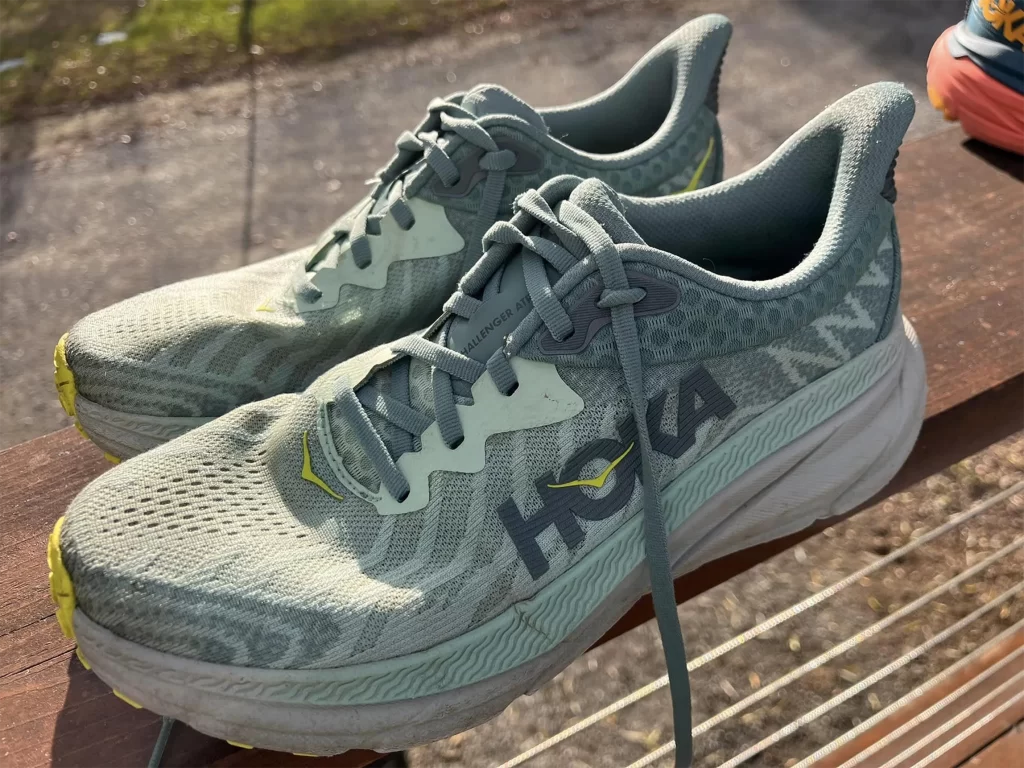
Testing the Hoka Challenger 7 GTX, I was immediately impressed by its plush cushioning. It’s like running on a cloud, yet the shoe still provides a sense of connection to the ground. The transition from road to trail is smooth, and the increased stack height is a boon for cushioning without compromising stability. The Air Mesh upper, coupled with the Gore-Tex membrane, ensures breathability and dryness, even when splashing through puddles or caught in a downpour.
On technical trails, the Challenger 7 GTX holds its own, offering a secure foot lockdown that instils confidence through rocky and uneven terrain. The shoe’s versatility shines when moving from such trails back onto the road, where it feels just as at home.
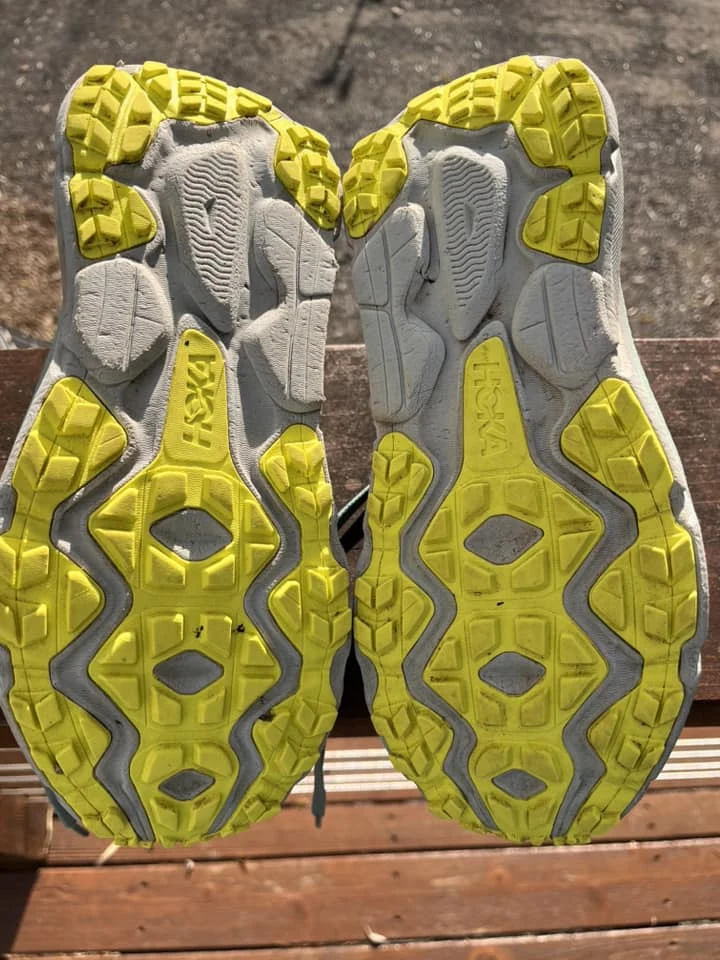
Pros:
- Versatile Use: Excelling on both road and trail, the Challenger 7 GTX is a true all-terrain shoe. Its outsole and design provide stability and grip on uneven trails, yet it’s smooth and responsive on the pavement.
- Increased Stack Height for Cushioning: With a stack height of 31mm at the heel 26mm at the forefoot for men, and 29mm/24mm for women, it offers plush cushioning that Hoka is known for, delivering a comfortable ride without feeling overly bulky.
- Lightweight Construction: Despite its substantial cushioning and waterproof features, it remains impressively light, making it suitable for long distances without weighing down the runner.
- Gore Invisible Fit Technology: The Gore-Tex Invisible Fit liner provides waterproof protection while maintaining a light and flexible feel, ensuring feet stay dry without sacrificing comfort.
Cons:
- Fit: The fit may feel narrow for some, especially since there is no wide option available for the GTX model. This could be a concern for runners with wider feet or those who prefer a roomier toe box.
- Traction: While the outsole is designed for versatility, it may not provide the same level of grip in winter conditions as some might expect from a GTX shoe. Runners may desire a more aggressive tread for icy or muddy conditions.
Nike Pegasus Trail 4 Gore-Tex (Best for Road and Trail)
The Nike Pegasus Trail 4 Gore-Tex is a versatile shoe that has garnered attention for its ability to transition smoothly from road to trail, making it an ideal choice for runners who enjoy both terrains.
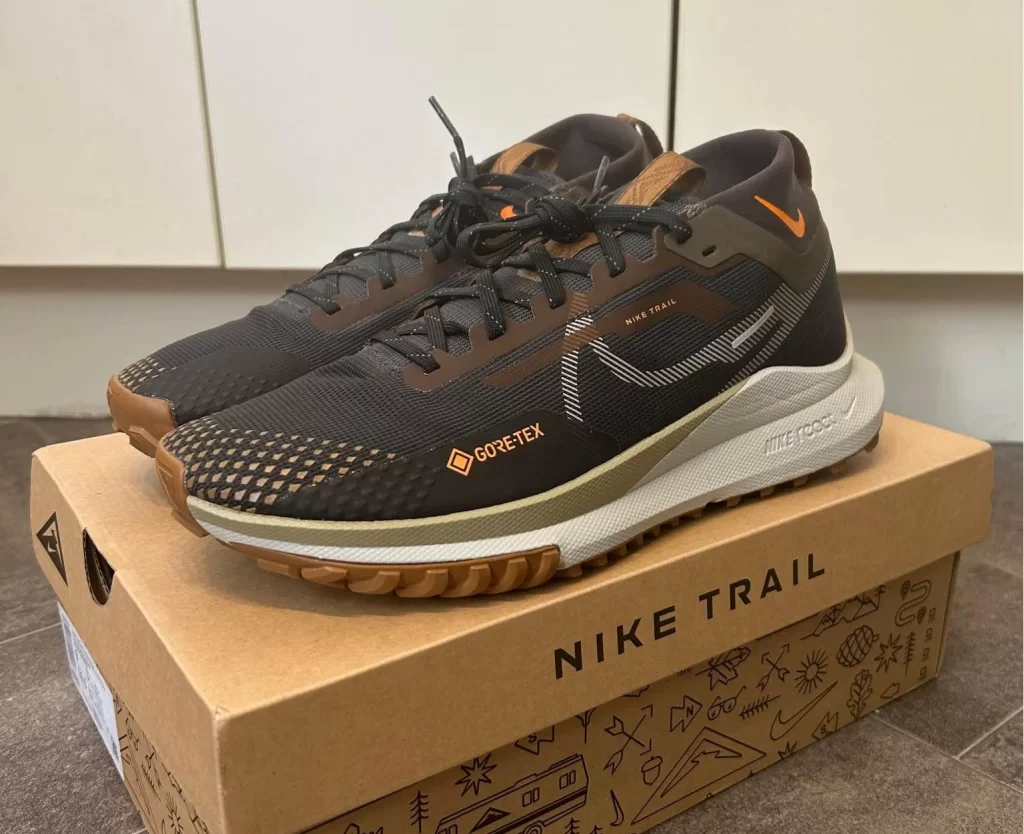
The Nike Pegasus Trail 4 GTX stands out with its ability to handle both road and trail surfaces with ease. Its design is not just functional but also aesthetically pleasing, maintaining Nike’s reputation for creating visually appealing footwear. The shoe features a waterproof Gore-Tex upper, which ensures your feet stay dry during runs through puddles and in wet conditions. However, it’s worth noting that the waterproofing is primarily in the lower area of the upper.
The outsole of the Pegasus Trail 4 GTX has been significantly improved, with a new rubber compound that offers better grip and traction on wet surfaces. This makes the shoe a strong performer on trails with wet rocks and leaves, although it’s not designed for extremely technical terrains with heavy rock and root exposure. The lugs provide sufficient traction without being so deep that they’re uncomfortable on the road.
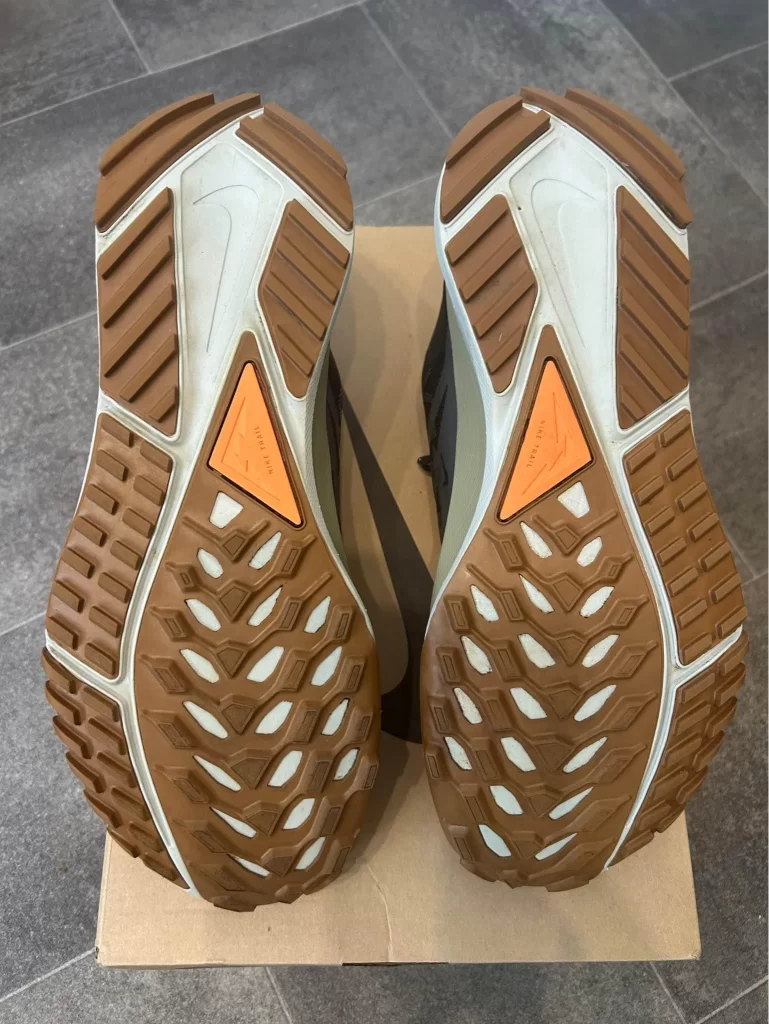
The Nike Pegasus Trail 4 GTX is highly recommended for runners looking for a shoe that can handle various conditions and terrains. Its combination of comfort, style, and functionality makes it a standout choice for road-to-trail adventures. Whether you’re out for a casual jog or tackling uneven paths, the Pegasus Trail 4 GTX is equipped to provide a comfortable and secure running experience.
Pros:
- Versatile Traction: The outsole provides reliable traction on both wet and dry surfaces, making it suitable for a variety of terrains. It’s not overly aggressive, which means it’s comfortable on the road, yet practical enough for most trail conditions.
- Responsive Cushioning: The full-length React foam midsole delivers a ride that is both cushioned and responsive. It’s a midsole that can handle long distances without compromising on comfort or energy return.
- Built-in Gaiters: The shoe features built-in gaiters that help keep debris out, which is particularly useful on loose and unpredictable trail surfaces.
Cons:
- Breathability: While the Gore-Tex upper is excellent for waterproofing, it does sacrifice some breathability. This could lead to warmer feet, especially in mild or hot weather conditions.
- Waterproof Limitations: The waterproofing is effective up to a point on the upper. The tongue design means that deeper water can penetrate the shoe, so it’s not suitable for very deep puddles or streams.
- Price: With a retail price of $160, it’s on the higher end, which might not be accessible to all runners. However, discounts are often available.
Adidas Terrex Agravic Flow 2.0 Gore-Tex (Best for Transitioning from Road to Trail)
After lacing up the Adidas Terrex Agravic Flow 2.0 Gore-Tex, it’s clear that this shoe is built for those who don’t see boundaries between the asphalt and the trail. Here’s my take on its performance:
The Agravic Flow 2.0 GTX is a shoe that doesn’t shy away from any terrain. The transition from road to trail is seamless, with the shoe providing a stable and secure ride regardless of the surface. The Lightstrike foam, while firm, offers a ride that’s both protective and responsive, making long runs less taxing on the feet.
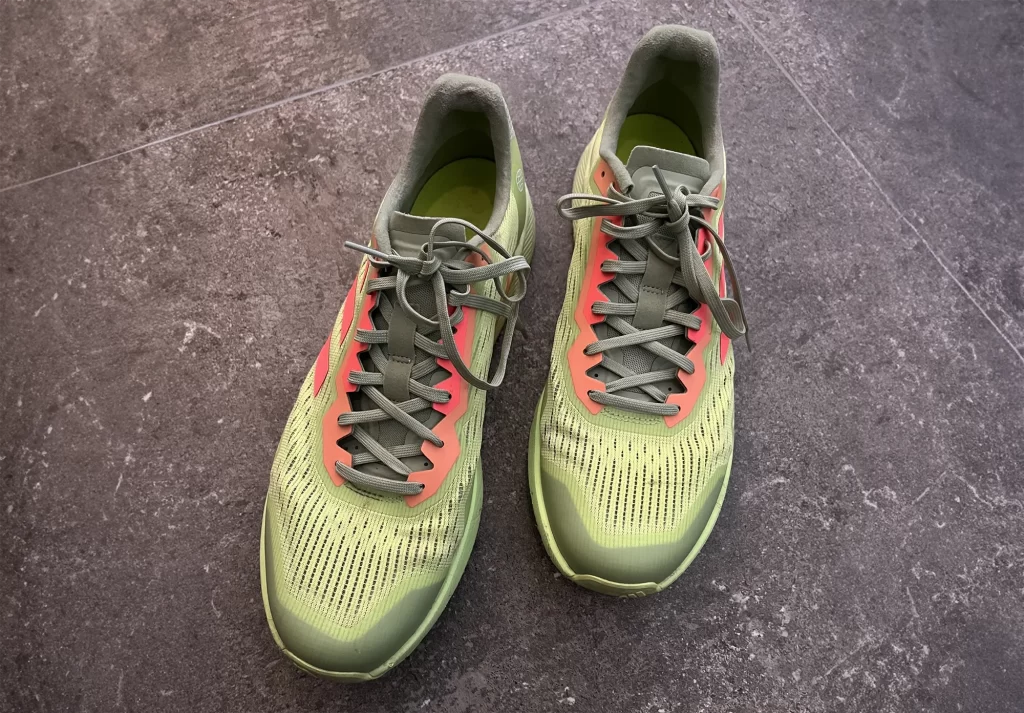
The upper is robust and holds up well against trail debris, yet it doesn’t suffocate the feet, thanks to its breathable lining. This is particularly noticeable on warmer days or during runs transitioning from cool forests to open, sun-exposed roads.
The shoe’s outsole is a standout feature. The Continental rubber grips well in both dry and wet conditions, giving a sense of security on trails that can sometimes feel like obstacle courses. The lugs are well-designed, providing traction without being so aggressive that they become uncomfortable on harder surfaces.
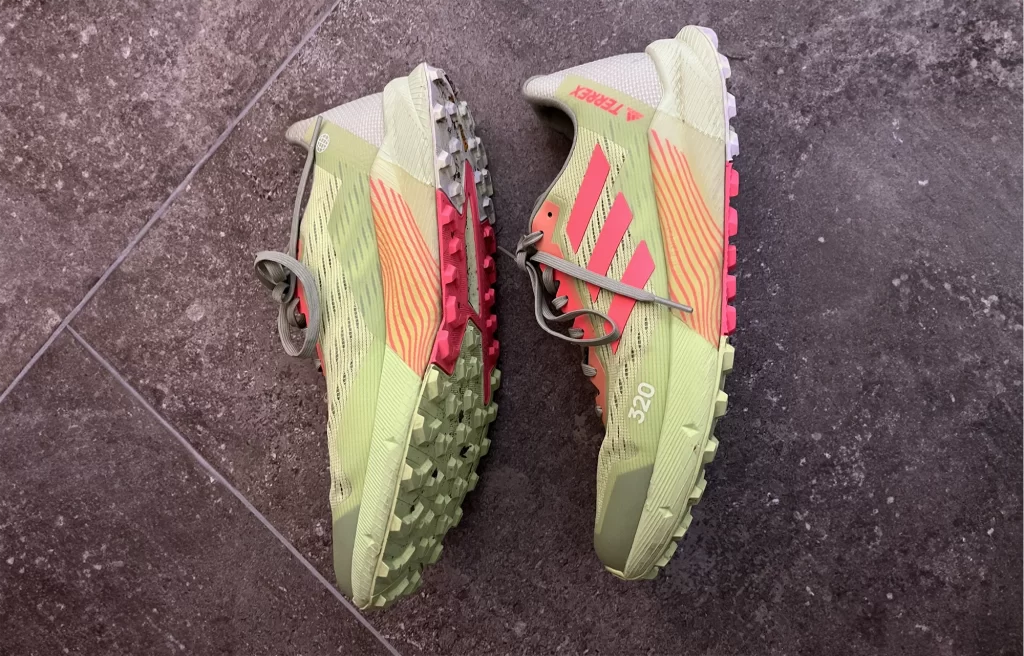
However, it’s not without its drawbacks. The stiff heel counter can be unforgiving, especially during the break-in period. It’s something to be mindful of when trying on the shoe. Additionally, the lacing system could be improved. I found myself stopping to adjust the laces and tongue more often than I’d like, which can break the rhythm of a run.
Pros:
- Responsive Cushioning: The Lightstrike midsole foam is firm, giving a responsive ride that feels energetic on both road and trail. It’s a cushioning that’s not too plush, allowing for a feel of the terrain without compromising on comfort.
- Breathable Upper: Despite its waterproof capabilities, the upper is surprisingly breathable, which is a boon during long runs where feet might otherwise overheat.
- Excellent Traction: The Continental rubber outsole offers excellent grip on a variety of surfaces. Whether it’s wet rocks or loose gravel, the shoe provides confidence-inspiring traction.
- Protective Details: Reinforced rubber at the front of the toe box is a thoughtful touch, offering protection against unexpected toe-stubs on roots or rocks.
Cons:
- Stiff Heel Counter: The heel area is quite stiff, which can lead to discomfort or blistering if not laced properly or if the shoe doesn’t fit perfectly.
- Lacing System: The laces and tongue require attention; they tend to loosen and shift, which can be a nuisance on longer runs.
How to Choose the Right Waterproof Running Shoe
Selecting the perfect waterproof running shoe can be as nuanced as choosing a fine wine. It’s about personal preference, intended use, and the unique characteristics of your feet and running style. Here’s a mini-guide to help you navigate the decision-making process:
Understand Your Foot Type:
- Arch Type: Know whether you have flat feet, high arches, or neutral arches. Flat-footed runners may need more support to prevent overpronation, while those with high arches might require more cushioning.
- Width: Ensure the shoe accommodates the width of your foot comfortably. Some brands offer wide options, which can be a godsend for runners with broader feet.
Assess Your Running Style:
- Gait Analysis: Consider having a professional gait analysis. This can provide insight into your running mechanics and help you choose a shoe that complements your natural movement pattern.
- Heel Striker or Forefoot Runner?: The point of impact when your foot lands can dictate the level of cushioning and the type of heel-to-toe drop that’s best for you.
Consider the Terrain:
- Road Running: If you’re primarily a road runner, look for a shoe that offers a smooth transition, good cushioning, and a comfortable fit.
- Trail Running: Trail runners should prioritize traction, stability, and underfoot protection. A more aggressive outsole may be necessary for muddy or technical trails.
- Mixed Terrain: For those who run on various surfaces, a hybrid shoe with versatile traction and moderate cushioning might be the best bet.
Factor in the Weather:
- Climate: If you’re running in colder climates, a shoe with less mesh and more protection might be necessary, whereas in milder climates, breathability could take precedence.
- Waterproof vs. Water-Resistant: Decide if you need a fully waterproof shoe (like those with a Gore-Tex membrane) or if a water-resistant shoe will suffice for your environment.
Prioritize Comfort and Performance:
- Try Before You Buy: Always try on running shoes before purchasing, if possible. A shoe might look perfect on paper but could feel different on your feet.
- Break-in Period: Be aware that some waterproof shoes may have a stiffer feel initially and might require a break-in period.
- Return Policy: Look for stores or brands with good return policies, allowing you to return shoes after a trial run if they don’t meet your expectations.
By considering these factors, you can narrow down your choices and select a waterproof running shoe that not only keeps your feet dry but also supports your running adventures, no matter where they take you. Remember, the right shoe is out there; it’s just a matter of finding the one that fits your feet as well as it fits your running lifestyle.
Caring for Your Waterproof Running Shoes
Investing in a pair of waterproof running shoes is just the first step. To ensure they serve you well over many miles, proper care and maintenance are key. Here’s how to keep your waterproof runners in top condition:
Routine Cleaning:
- Post-Run Knock: After each run, especially if you’ve been on muddy trails, knock your shoes together outside to remove excess dirt.
- Surface Clean: Use a soft brush or cloth to gently remove dirt. For stubborn spots, a mild soap and water solution can be used, but avoid harsh detergents.
- Air Dry: Let your shoes dry naturally at room temperature. Avoid direct heat sources like radiators or hairdryers, as high heat can damage the waterproof membranes and adhesives.
Deep Cleaning:
- Remove Insoles: Take out the insoles and wash them separately to ensure they dry completely.
- Hand Wash: Submerge your shoes in a bucket of lukewarm water and gently scrub. This method allows you to clean without soaking the inner layers too much.
- Freshen Up: To combat odours, sprinkle baking soda inside your shoes and let it sit overnight before shaking it out.
Waterproofing Treatments:
- Assess the Need: If you notice that water no longer beads off the surface of your shoes, it might be time for a waterproofing treatment.
- Choose the Right Product: Use a treatment compatible with your shoe material. For example, silicone-based sprays for leather and fluoropolymer-based products for synthetics.
- Follow Instructions: Apply the treatment as directed, usually on a clean, dry shoe, and allow it to set for the recommended time.
Storage:
- Keep Them Dry: Store your shoes in a dry place with good airflow to prevent mildew and maintain the integrity of the waterproof membrane.
- Avoid Compression: Don’t pile heavy items on your shoes, as this can deform them and affect their fit and performance.
Regular Inspection:
- Check for Wear: Regularly inspect your shoes for signs of wear and tear, particularly the tread and waterproof lining. Catching issues early can extend the life of your shoes.
- Mind the Mileage: Keep track of the miles you’ve put on your shoes. Waterproof running shoes typically last between 300 to 500 miles, depending on the terrain and your running style.
When to Replace:
- Listen to Your Feet: If you start to experience discomfort or wetness, consider a new pair.
- Visible Damage: Any separation between the sole and the upper, or noticeable holes, means the shoe no longer provides the protection it should.
By following these care tips, you’ll maximize the life of your waterproof running shoes, ensuring they remain a reliable ally against the elements for as long as possible. Remember, a little TLC can go a long way in extending the life of your favourite running gear.
Alternatives to Waterproof Shoes
While waterproof running shoes are a fantastic solution for many wet conditions, there are scenarios where alternatives like waterproof socks and trail-running gaiters might be preferable or necessary. Let’s explore these options and understand when they might come in handy.
Waterproof Socks:
- Layer of Protection: Waterproof socks serve as an additional barrier between your feet and the elements, which can be particularly useful if you’re running in shoes that aren’t waterproof or if you’re facing extremely wet conditions.
- Material and Build: These socks are typically made with a waterproof membrane sandwiched between a durable outer layer and a moisture-wicking inner layer, keeping your feet dry from external water and internal sweat.
- When to Use: They’re ideal for cold and wet conditions where you need an extra layer of insulation. They can also be a cost-effective solution if you’re not ready to invest in waterproof shoes.
Trail-Running Gaiters:
- Debris Blockers: Gaiters are worn over the running shoe and lower part of the leg. They’re excellent for keeping out debris like rocks, sand, and snow, which is especially useful on loose and technical trails.
- Water-Resistant vs. Waterproof: Some gaiters are water-resistant, offering a degree of protection against light moisture, while others are fully waterproof for more extreme conditions.
- When to Use: Gaiters are a top choice for trail runners who frequently encounter debris. They’re also great for runners who have a preferred non-waterproof running shoe but need to keep out moisture on occasion.
Scenarios for Alternatives:
- Changing Conditions: If you’re running in an area where conditions can change rapidly, having waterproof socks or gaiters allows you to adapt without changing your entire shoe.
- Breathability Preference: Some runners find waterproof shoes too warm or insufficiently breathable. In these cases, using breathable shoes with waterproof socks or gaiters can provide a happy medium.
- Economic Considerations: Investing in waterproof socks or gaiters can be more economical, especially if you occasionally run in wet conditions and don’t need a dedicated waterproof shoe.
Combining Alternatives with Non-Waterproof Shoes:
- Layering: You can layer waterproof socks with non-waterproof, breathable shoes for a combination of moisture protection and breathability.
- Versatility: Gaiters can be added to your favourite trail-running shoes to protect against moisture and debris, giving you the flexibility to use the shoes you love in a wider range of conditions.
Frequently Asked Questions (FAQs)
When it comes to waterproof running shoes, several questions often crop up. Here are some of the most common inquiries and their answers:
How long do waterproof running shoes last?
Waterproof running shoes typically have a lifespan similar to that of regular running shoes, which is around 300 to 500 miles. However, the durability can be influenced by factors such as the running surface, the care you provide, and the quality of the shoe. Regular maintenance and cleaning can help extend their life.
How should I wash my waterproof running shoes?
To wash your waterproof running shoes, first remove any excess dirt or mud. Use a soft brush and a mild soap mixed with water to gently clean the shoes. Avoid immersing them completely in water, and never put them in the washing machine. After washing, let them air dry away from direct heat sources to preserve the integrity of the waterproof membrane.
Can I use waterproof running shoes for everyday wear?
You can absolutely use waterproof running shoes for everyday wear. They offer the added benefit of keeping your feet dry in wet conditions, which can be particularly useful in rainy climates or during the winter months. However, remember that they may not be as breathable as non-waterproof shoes, which could affect comfort during prolonged use or in warm conditions.
Are waterproof running shoes more expensive than non-waterproof running shoes?
Generally, waterproof running shoes are more expensive than their non-waterproof counterparts due to the added technology and materials required to make them water-resistant. The price difference can vary, but you are paying for the additional feature of keeping your feet dry in wet conditions, which can be invaluable for some runners.
Remember, choosing the right waterproof running shoe is about more than just keeping your feet dry; it’s about finding the right balance between waterproofing, breathability, comfort, and durability to suit your specific running needs.

